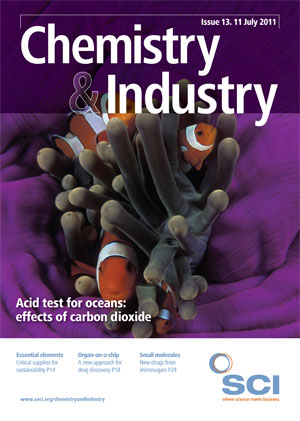The green energy revolution marches on: research by Pew Charitable Trusts shows that global spending on clean energy technologies soared by 30% last year – with China, Germany and the US leading the charge. But while the sun, wind and the tide might seem very natural sources of power, harnessing useful energy from them is incredibly difficult. Sustainable energy technologies rely on some of the rarest elements on the planet, the future supply of which is far from secure.
Energy critical elements
‘Traditional energy technologies – burning coal, oil and gas – are pretty simple,’ says Robert Jaffe, professor of physics at Massachusetts Institute of Technology (MIT) in the US. ‘The technologies of solar and wind power and other renewables are very sophisticated. If you make a commitment to one of them, and you get a supply problem, you’re in big trouble. This makes investors nervous. It will slow development down – and we can’t afford for that to happen.’
In his role as chair of the American Physical Society (APS) panel on public affairs, Jaffe led a study committee into the subject. In collaboration with the Materials Research Society, APS produced a report, Energy critical elements: securing materials for emerging technologies. The report finds that these ‘energy critical’ elements are the many scarce materials that are at the heart of these new technologies. Many of them, including tellurium and indium, are vital in thin-film photovoltaics; dysprosium is used in high-strength permanent magnets for applications such as wind turbines; and yttrium, a rare earth element, is an important component in energy-efficient solid-state lighting.
The report states that an element may be energy-critical for a number of reasons: it may be intrinsically rare in the Earth’s crust, like tellurium or rhenium; it may, like indium, be unevenly distributed, making the US highly reliant on imports; or it may be poorly concentrated by natural processes and difficult to extract economically, such as germanium. Germanium is 20 times more abundant than silver, but rarely forms minerals in which it is the principal component. It is produced as a byproduct of zinc extraction.
Jaffe comments that the growth in sustainable energy technologies has changed the nature of what people expect to dig out of the ground. ‘If these new technologies are going to solve the energy crisis, they will have to be deployed on a huge scale,’ he says. ‘To deliver that, we will need relatively massive amounts of these chemical elements, which have never been important to industry before.’
Mining spin-offs
There are no mines for tellurium, indium or selenium. Instead, they are extracted in small amounts when digging for gold, copper or zinc. They are byproducts of other mining processes. This is known as ‘co-production’. Tellurium, for example, is critical to solar power. Despite being as rare as gold, it is relatively cheap because it ‘falls out of the refining of copper’, explains Jaffe. Its estimated annual production is just 200t – though the report stresses that this is just an estimate. Other elements used in solar energy – indium, gallium and selenium – are also co-products of copper mining. This keeps their price relatively low, but co-production may not be enough as demand continues to soar. ‘Nobody knows what the price of these things would be if they were mined on their own,’ he says.
There has been recent speculation that some elements might become ‘extinct’, but Jaffe is not convinced by this. ‘We are nowhere near exhausting these resources,’ he says. ‘They just haven’t been looked for in sufficient quantities.’
It is unlikely that the mining of copper – with a production value of around $80bn in 2009 – would be driven by an increased demand for tellurium – with a value of $30m in 2009. But the way that copper ore is processed might well be modified to obtain more tellurium, says the report. The problem is more about scarcity, because many of these elements can only be sourced in a few countries: many rare earth elements (REEs), for example, are currently only produced in China, which makes countries like the US and Japan nervous. ‘There’s a short-term problem with rare earth elements that must be sorted out at government level,’ says Jaffe, adding, ‘I don’t think that science or mining will alleviate that shortage over the next three or four years.’ By 2015, he says, there may be alternative sources of REEs outside China, but until then, potential users must negotiate for their supply.
Critical assessment
Another committee member, Thomas Graedel of Yale University, is looking into ways of assessing the long-term ‘criticality’ of each element accurately. The starting point for this was a 2008 report by the National Academy of Sciences in the US, Minerals, critical minerals and the US economy. ‘[The report] promoted the concern, but said little about how to implement it,’ says Graedel. ‘It suggested that we needed to evaluate both the supply risk – whether a material is available or not – and the impact on activities if it were not available.’
Graedel, director of Yale’s Centre for Industrial Ecology in the school of forestry and environmental studies, says that a methodical assessment of a number of critical factors will lead to a set of numerical scores. He expects the first assessments to be finished during the summer. Papers will then be submitted to journals for publication. ‘We should be able to report something by the end of this year,’ he says. Some of the factors to consider include: the geology of where minerals exist; the political situation in the country of origin; the acceptability of mining in certain areas; and whether there are potential substitutes.
Weighing these factors up, and getting a true measure of the risk, will allow companies and countries to make better decisions – similar to General Electric’s 2006 redesign of its turbine alloys in anticipation of a rhenium shortage. Aero engines use around 30 different materials, including cobalt, rhenium, vanadium and other rare elements. ‘Many commercial producers, such as jet engine manufacturers, need to supply replacement parts,’ he says. ‘You want the materials that you design into your engine in 2010 to be available in 2030. At the moment, we don’t know if that will be the case.’
A certain irony
And while energy is the subject of most concern, it is apparent that many other sophisticated technologies – electric cars, medical imaging and mobile electronic device, for example – are also clamouring for access to these materials. There is also a certain irony in the fact that green energy will only be successful if we carry out much more mining. But Graedel believes this is simply a progression of what has always happened. ‘Humans have a long history of taking advantage of a variety of materials and using them ingeniously to make things that are better than before,’ he says. ‘These days, we’re moving from common materials like iron and copper to these scarce materials that have very specific properties.’
Unusual suspects

Solar power: gallium, germanium, indium, selenium, silver, tellurium
Wind power: dysprosium, neodymium, samarium, cobalt
High-performance batteries: lithium, lanthanum
Fuel cells (as catalysts): platinum, palladiumLiquid advantage
A surprising example of an energy-critical element is helium, which is not usually seen as a ‘rare’ element. Helium’s specific chemical and physical properties – and the way in which it is collected – mean that it could become a critically endangered species of the chemical world. ‘Helium remains a liquid right down to absolute zero,’ says Robert Jaffe. ‘You can bombard it and it will not become radioactive. It’s a superior material to use in a nuclear energy environment: there is no substitute.’

Ever since the US began tapping natural gas, it has had a progressive attitude towards helium. The industry has ‘husbanded’ it since the 1930s, knowing its true value. The US government has traditionally stockpiled helium, but, in the face of cutbacks, recently decided to start selling it off. ‘We have urged them to reverse that decision,’ says Jaffe.
The only alternative source of helium is to extract it directly from the air – which is not economically feasible because it comprises less than 5ppm.
Helium is a special case because it is a gas. Indium is a byproduct of zinc mining and, if its price goes too high, the ‘tailings’ can be processed to extract it. ‘That won’t work with helium,’ says Jaffe. ‘If you don’t capture it, it’s gone forever.’
Lou Reade is a freelance science writer based in Kent, UK.





